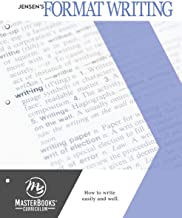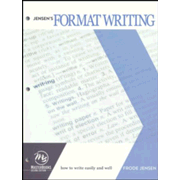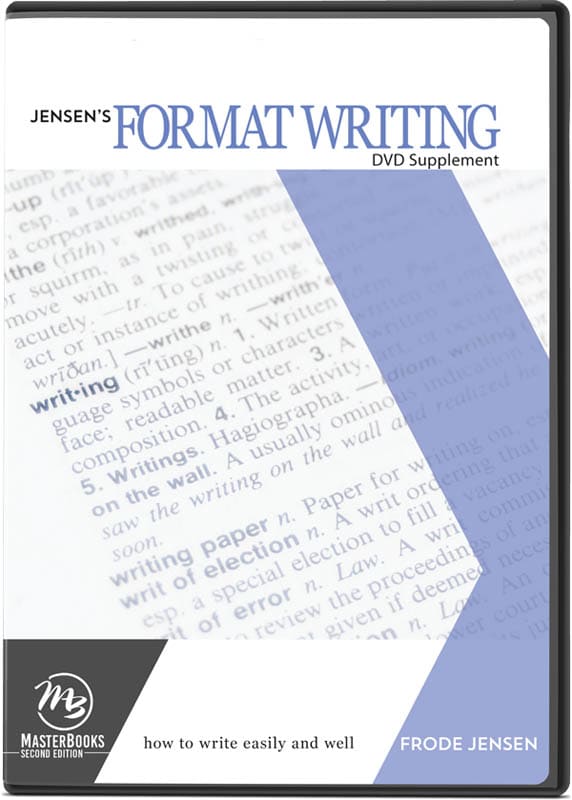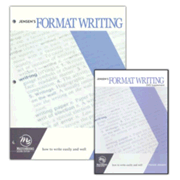In this outstanding book, Frode Jensen passes on the wisdom and skill he has gained from years of experience teaching writing. His focus is expository writing. I appreciate his strategy of beginning with paragraph writing rather than assuming that students have mastered this skill by junior high—which is rarely the case.
The content covers five major areas of writing, most of which need to be learned consecutively: paragraph writing, essay writing, practical writing, business writing, and major papers. Jensen also includes a lesson on continuity, a topic rarely addressed in similar resources. These are the major writing skills that should be developed in junior and senior high school, Jensen’s targeted levels for this book.
Students tackle paragraph writing by working with a seven-sentence format that begins with a topic sentence and ends with a conclusion. They write seven different types of paragraphs: example, classification, definition, process, analogy, cause-and-effect, and comparison. The number of each type of paragraph that students produce will depend upon the time available to the teacher.
Sufficient practice at this stage prepares students for the next section—the five-paragraph essay. Students follow the format described in the book, writing seven different types of essays just as they do with paragraphs. In this and other sections, Jensen provides detailed, step-by-step instructions and examples.
Within the practical writing section are lessons on book reports and responding to essay questions on tests. Business writing covers writing various types of letters as well as a résumé. These lessons might be used anytime after the paragraph lessons.
Before moving on to writing lengthier papers, Jensen teaches the principle of condensation—how to sort through research information to identify the essentials. Students can then transfer the crucial points into their own papers without wasting both their own time and their readers’. Students practice précis writing (condensing and summarizing) with samples within Format Writing as well as others the teacher assigns. Précis writing is an important skill, largely neglected or treated very briefly in most high school courses.
The final section deals with major papers—reports or research papers of at least 1000-1200 words. Jensen teaches the traditional note card organizational method, supplemented with detailed instructions for title pages, citation methods (including CD-ROM or internet citations), abbreviations, bibliographies, and appendices. Instructions for the various assignments are all quite detailed and there is an index at the back of the book—both are valuable features for student and teacher.
Jensen includes reproducible check-off forms at the end of the book for evaluating writing assignments. These are extremely useful since Jensen includes a point system and detailed instructions for evaluation that will teach parents with little writing background how to evaluate their teens’ work. Sample schedules and scheduling tips also help the inexperienced teacher judge how many assignments to use and how long each should take. Two tests may also be used for evaluation purposes.
Some exercises are included in lessons as a means of helping students work through aspects of writing critical to success with the particular format targeted in that lesson. An answer key for the few exercises with predictable answers is included.
Format Writing has a few instances of non-denominational Christian content, primarily in some examples and exercises. For instance, students are instructed to write thesis statements for ten different ideas, one of which has to do with explaining the meaning of “faith,” and another of which has to do with comparing two Christian hymns. In the section on book reports, he urges students to write about whether or not the central idea of the book “squares with Scripture.”
This book should be suitable for junior high through college level, so you can use it across a wide span of age/skill levels. Also, while Jensen employs a formula approach to writing, it is not as strictly structured as are some other formatted approaches. Jensen’s approach should be very helpful for parents who need the structure for themselves as much as for their students. Students can do most of their work independently. However, discussion of some of the lessons would be helpful, and parents need to evaluate student work, so parents should at least read through the lessons.
An optional, supplemental DVD helps the inexperienced parent/teacher effectively teach this course. Through twelve lectures, Frode Jensen explains how the course works and adds teaching and motivational tips.













